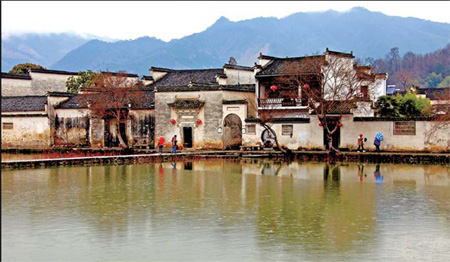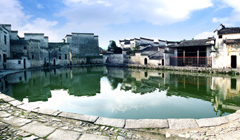Two 'treasures' to tempt Expo visitors
2010-04-15
 |
|
Hongcun village, which looks like a traditional Chinese ink painting, is one of Anhui's most visited sites. Shi Guangde / Asia News Photo |
The upcoming 2010 World Expo promises to be a bonanza for Shanghai's tourism industry, and many visitors attending the international showcase will also journey outside the city to nearby provinces such as Anhui, Jiangsu and Zhejiang.
At least one third of the expected 70 million Expo visitors are expected to make a sojourn outside Shanghai to neighboring provinces, according to the National Statistics Bureau.
Only three to four hours drive from Shanghai, the natural beauty and rich culture and heritage of Anhui provide a great escape from the urban vistas of the metropolis and are sure to attract many visitors.
"Anhui has the Huangshan Mountains, which are just like a traditional Chinese ink painting, Hongcun village and Tunxi Old Street, which could well date back over 1,000 years, as well as the country's oldest paper and ink cultures," says Hu Xuefan, director of the Anhui tourism bureau.
The Chinese writing brush, ink stick, ink stone and paper are known as the "Four Treasures of Chinese Study", and Anhui province can claim to be the place of origin of two of them: Xuan paper and Hui ink sticks. The majority of the ancient Chinese books and paintings by famous painters that still survive were created using Hui ink sticks and Xuan paper.
Named after ancient Anhui's Xuanzhou prefecture, where the finest quality paper was traditionally produced, Xuan paper is renowned for its fine texture and durability, some Chinese calligraphy collectors believe that top quality Xuan paper will last forever.
There are numerous kinds of Xuan paper and each paper manufacturer has its own carefully guarded secrets.
Neighboring She county is renowned for producing Hui ink, the country's best ink sticks. With pre-mixed liquid ink available nowadays, why do painters and calligraphers still insist on grinding their own ink? People from She county know the answer: The texture and quality of freshly ground ink is better, and people like to relax their muscles and prepare for using the brush by grinding the ink.
Hui ink sticks used to be known as Li sticks, as the late Tang emperor Li Yu (AD 936-978) was a great admirer of their qualities and it used to be said that it was easier to get gold than a Li ink stick.
So if you are visiting the Expo and want a little relief from the hustle and bustle of Shanghai, why not pay a visit to Anhui province and discover these Chinese treasures for yourself.
China Daily
(China Daily 04/15/2010 page19)



